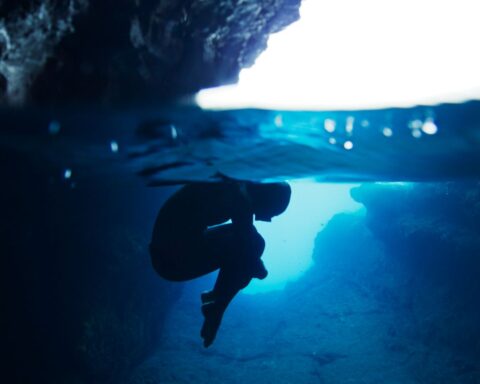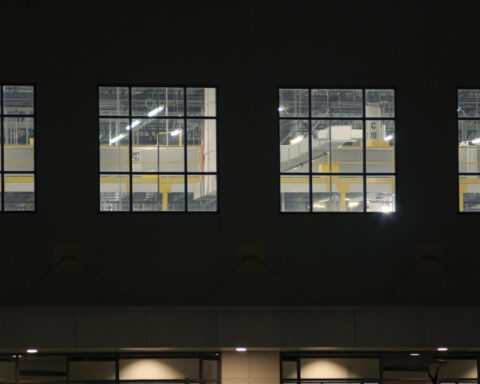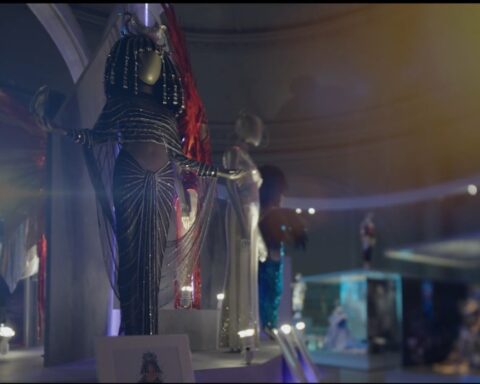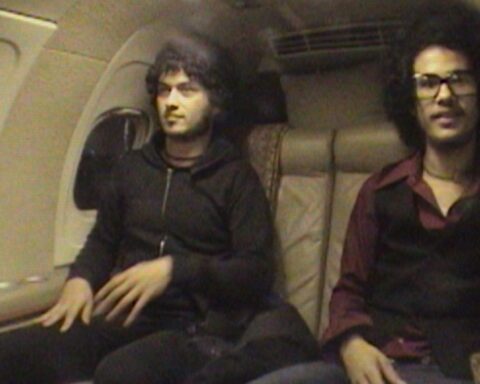When you think about documentaries, certain things come to mind: verité shooting, archival footage, interviews, narration. Embedded in this idea of what could be called the “well-made doc” is a set of assumptions that largely reduces documentary to fact and to narrative. There’s nothing wrong with that, of course, and most documentaries fit into that idiom: they tell a story and argue for an interpretation of it. Yet there is much in the realm of documentary that does not adhere to these conventions. Maintaining the fundamental documentary instinct to reflect reality, these films nevertheless depart from that narrative form, imaginatively manipulating documentary techniques to investigate less tangible realities.
In fact, the “well-made doc” is a relatively recent invention; the impulse to document reality in creative ways goes back much further, giving rise both to the well-made doc and a multitude of other approaches. Robert J. Flaherty’s Nanook of the North (1922)—arguably the first feature-length documentary—is largely staged, and other early documentaries like Walter Ruttmann’s Berlin, Symphony of a City (1927) and Dziga Vertov’s The Man with the Movie Camera (1929) incorporate experimental shooting and editing techniques into essayistic, poetic, even musical meditations on modernity. From the 1950s onwards, filmmakers around the world like Stan Brakhage, Chris Marker, Trinh T. Minh-ha, Fernando Solanas, Agnès Varda, Su Friedrich, Joshua Oppenheimer, and many others made and continue to make contributions.
I am calling this expansive undercurrent of the documentary genre, which ranges between the worlds of experimental film, video art, independent film and documentary, ‘conceptual documentary.’ No stylistic sensibility or common concerns link them. You’re as likely to see them at Toronto’s Images Festival or in an art gallery as at the Rencontres internationales du documentaire de Montréal (RIDM) or the Vancouver International Film Festival (VIFF). Instead, it’s their shared tendency to reinvent documentary for diverse personal purposes, which tend towards abstraction and expression, that makes it fruitful to consider them together.
In Canada, the story begins with three experimentalists of the 1960s: Arthur Lipsett, Jack Chambers and Michael Snow. Born in Montreal in 1936, Lipsett was mentored at art school by the Group of Seven’s Arthur Lismer before beginning to work at the NFB in the late 1950s. His oeuvre of short films combines technical wizardry and radical sociopolitical insights with accessible, albeit sophisticated, aesthetics influenced by contemporary American independent filmmakers like Bruce Conner, Kenneth Anger and Stan Brakhage.
Very Nice, Very Nice, Arthur Lipsett, provided by the National Film Board of Canada
Lipsett’s first film, Very Nice, Very Nice (1961), pioneers avantgarde film techniques of audiovisual montage and collage to create a satirical portrait of Canada in the early 1960s. Lipsett reveals the anxieties underlying the triumphalist official post-war narrative, portraying a society dominated by capitalism, consumerism, fragmentation, superficiality and martial values. Beginning with a John Grierson-esque Voice of God narration, it is cut off abruptly by comic sound effects. Throughout the film, pomposity is undercut by humour, with its hypocrisy revealed through unexpected juxtapositions. Referencing and appropriating staid documentary tropes of street photography, archival news footage and omniscient narration, Very Nice, Very Nice playfully subverts the ideology implicit in those conventions with exuberant, rhythmic and satirical concision. It was nominated for an Academy Award for 1961.
A painter of the self-proclaimed ‘perceptual realism’ style who created celebrated enigmatic renderings of quotidian southern Ontario scenes like 401 Towards London No. 1 and Sunday Morning No. 2, Jack Chambers made a brief but monumental foray into filmmaking in the 1960s. After making a series of interesting but littleseen short films, Chambers embarked on what would become his masterpiece, The Hart of London (1970). An 80-minute feature that meditates on nature, violence, civilisation, spirituality and morality, it was praised by iconic American experimental filmmaker Stan Brakhage and is a cornerstone of Canadian cinema.
The film begins with archival news footage of a deer wandering into London, Ontario, from the nearby forest. Pursued through the town’s streets and backyards, the deer is eventually killed by the inhabitants of the town it has invaded. The three-part structure that follows pairs three distinct aesthetics with their respective contents. First, there is an incredibly fast montage of archival material of archetypal city scenes and their natural environments: factories, cars on streets, a gardener clipping a hedge and so on. In the middle is the film’s most famous section: the brutal and ecstatic juxtaposition of the birth of Chambers’ son and the killing of a sheep. Third is home-movie-style footage, mostly of Chambers’ family. The film’s final section echoes the beginning: Chambers’ sons cautiously approach and feed a deer in a zoo, while the soundtrack has his wife repeatedly saying, “You have to be very careful.” The film ends with long, calm shots circling between a river and the sky as day turns to night.
The Hart of London identifies universal tensions—between civilisation and nature, birth and death, materiality and spirituality—that are impossible to resolve. Chambers’ biography offers some hints as to his own perspective: he had spent time in Spain, which had influenced his spiritual and artistic inclinations, but he had found the landscape alienating, and had returned to Ontario, developing a sort of ecstatic communion with its urban and natural environments before being diagnosed with terminal leukaemia in 1969 during the making of The Hart of London. We can assume the film represents for Chambers a sort of spiritual acceptance of life’s contradictions, but the poetics of his film are deliberately and rigourously ambiguous. The film ends up posing an ethical challenge, pointing out that the conflicts it identifies must be resolved differently and idiosyncratically person by person. As for Chambers, The Hart of London was the last film he finished.
Possibly Canada’s most important artist, Michael Snow experimented with film, starting in the 1960s with great success. Though his most influential film, Wavelength (1967)—a murder mystery comprised of a single 45-minute-long zoom across an apartment into a photo of waves—is not a documentary, another of his most notorious experiments is. For La région centrale (1971), Snow enlisted the services of a robot, onto which he mounted a camera in the vast, bleak central region of Quebec. In the film, shot over 24 hours but presented as a single long take, the robot does everything it can with the camera—pans, tilts, spins, zig-zags, in close-ups, wide shots, Dutch angles and even upside down. The film is three hours long. It’s a masterpiece of endurance cinema.
To understand the film, you need to understand not just the Canadian landscape but the way it has been represented. Whereas American Romantic landscape painting is blithely imperialist, depicting beautiful, wide landscapes ripe for settlement, the Canadian modernist response of the Group of Seven opts for smaller scenes that, while still excluding people (notably lacking Indigenous peoples) in a fantasised terra nullius, are somewhat starker than the American variety: Lorne Harris’ abstracted icebergs, Tom Thomson’s lone tree.
La région centrale goes a step further. It’s a rollercoaster ride that renders the landscape a sort of moonscape completely alien to humanity. The two elements of the film, the camera and the landscape, are independent of each other. The experience of watching the film—immersive, meditative, exhilarating, and exhausting by turns—encompasses both a vicarious immersion in a completely nonhuman—let us say post-human—perceptual apparatus and a sustained and multitudinous view of a completely non-human—pre-human—landscape.
Early conceptual documentaries in Canada prioritized formal and structural innovation, studiously experimenting with montage, camera movement, superimposition and the like in considering philosophical problems centring on classical dichotomies of nature and civilization, reality and representation, individual and society and so on. Filmmakers like Al Razutis and Richard Kerr continued to pursue those interests. But in the 1970s, the approach started to become somewhat less academic. Though still formally adventurous, the films of this generation are both more explicitly personal and more loosely structured, representing a progression from the earlier generation’s rigourous modernism.
An early step in this direction is Lisa Steele’s groundbreaking feminist masterpiece Birthday Suit – with scars and defects (1974), which shows the artist touching every scar on her body and scientifically recounting how and when she got them. A classic example of video art, Birthday Suit employs a rigid minimalist aesthetic similar to Snow’s—though more akin to the austere early work of Chantal Akerman—but replaces Snow’s nonhuman landscapes and Chambers’ spiritual inklings with the artist’s own body and biography, making it both more intimate and more confrontational than its ostensible predecessors. Since 1983, Steele has worked exclusively with her partner Kim Tomczak in lauded video work that continues to explore the theme of the individual in society using fiction and documentary elements.
Pursuing that personal turn, artists like Philip Hoffman, Mike Hoolboom and Steve Reinke developed the diary film form. Hoffman’s passing through/torn formations (1987) is arguably the defining entry from this genre. Taking, as Jack Chambers did, his life and family history as the film’s basic elements, Hoffman goes in more or less the opposite direction to Chambers. Where The Hart of London takes the quotidian facts of its creator’s life and abstracts them into universal themes via a rigid, parallel, thematic structure, Hoffman’s film delves into specificity via excavations of his family’s unique stories, building a flowing, polyphonic structure around his Czech-born grandmother’s impending death, his memories of her, a female cousin in Ontario and a trip to central Europe. Hoolboom and Reinke take similar approaches but apply them somewhat more directly to their generation’s defining crisis, AIDS, in works like Hoolboom’s Letters from Home (1997) and Reinke’s Hundred Videos (2002).
The work of two defining filmmakers of the 1990s and 2000s, Peter Mettler and Jennifer Baichwal, maintains some of the diarists’ spirit of introspection and meditation but take an outward turn towards new global and philosophical problems. Their films structure meditations on topics of perception, chance and globalisation around open-form studies of concrete topics.
In Mettler’s Picture of Light (1994), a trip to Churchill, Manitoba to film the northern lights leads not so much to a technical set of failures and successes as to a meditation on perception and awe at the vastness of the Arctic landscape and the beauty of the Lights, with many dreamy time-lapse shots as well as a sojourn into orbit to see them from space. It’s also an excuse to engage with the characters who populate the town, among them a Slovakian-born motel owner who demonstrates the power of Churchill’s snowstorms by drilling a hole in the motel’s door, eventually filling the room with snow, and an Inuit man who, having gotten frostbite after getting stranded out on the land for days, gets his toes amputated. Mettler’s next feature, the three-hour-long Gambling, Gods and LSD (2002), is a gloriously meandering global trip, following an impetus to document the pursuit of happiness and ecstasy in Las Vegas sex museums, evangelical churches, shopping malls and beyond.
In similar fashion, Baichwal’s Manufactured Landscapes (2006)— shot, in fact, by Mettler—extends a documentary about celebrated Canadian photographer Edward Burtynsky into an exploration of his favourite themes: industrialization, globalisation, pollution, nature, scale. All of these immediately come to the fore in the film’s famous opening shot. Inspired as much by Jean-Luc Godard and Jean-Pierre Gorin’s Tout va bien (1972) as by Burtynsky’s style and themes, Mettler lensed for Baichwal an eight-minute-long tracking shot in a Chinese factory that builds most of the world’s clothing irons, culminating in a photo by Burtynsky of the workplace. Baichwal’s Act of God (2009) takes off from a study of people who have been struck by lightning to include musings and recollections by author Paul Auster and a scientific study of the electrical workings of the brain of improvising guitarist Fred Frith. Baichwal’s collaborations with Burtynsky continued in the environmentally minded Watermark (2013) and in the forthcoming Anthropocene (slated for 2018).
Two idiosyncratic autobiographical works from the 2000s represent new takes on the conceptual documentary. Neither as formally experimental or as introverted as the diary films nor as philosophical as the films of Baichwal and Mettler, Guy Maddin’s My Winnipeg (2007) and Sarah Polley’s Stories We Tell (2012) seamlessly fuse documentary and fiction in questioning the distinction between reality and imagination.
Stories We Tell, Sarah Polley, provided by the National Film Board of Canada
Described by Maddin as a “docu-fantasia,” My Winnipeg is a sarcastic yet sentimental ode to Maddin’s hometown. The film retains a documentary’s attention to reality, flowing freely between Maddin’s childhood memories and reveries and the history and geography of Winnipeg. But it expands far beyond the genre’s conventions, waxing poetic about needing to escape “sleepwalking Winnipeg,” indulging in flights of fancy in episodes about horses frozen alive in Red River, a Canadian Pacific Railway-sponsored treasure hunt, a fictional superhero of the 1919 General Strike called ‘Citizen Girl’ and psychosexual dramatisations featuring iconic B-movie actress Ann Savage as Maddin’s mother, all in the director’s trademark visual aesthetic—a lo-fi surreal pastiche of antiquated film styles. It’s a delight. But don’t mistake its riotous collage of fact and fiction for randomness. For Maddin, understanding Winnipeg means understanding both the Forks and the Forks beneath the Forks.
Subtler and more emotional, Polley’s Stories We Tell investigates her family’s secrets. Initially focusing on the elusive figure of Polley’s mother, Diane, who died when the filmmaker was 11, and scripted recollections by her father, Michael, the film’s central realisation is Polley’s discovery that she was in fact born of an extramarital affair between her mother and film producer Harry Gulkin. Polley tells her story through interviews with Harry, Michael, her siblings and others, as well as through what, at first, appears to be archival footage but what, one eventually realises, must be staged recreations. The film’s mix of fact and fiction, which both alternates between them and entangles them in Michael’s staged autobiographical monologue and the faked archival footage, highlights the film’s epiphany: that identity, family and relationships are fictions upheld not by facts but by stories. To wit, Polley discovers that she feels closer to Michael than she had in years in the moment that she tells him he is not her father—the biological fact does nothing to undermine their hard won relationship.
Another area in which Canadian filmmakers have experimented is animated documentaries. Films like Chris Landreth’s Ryan (2004) and Theodore Ushev’s Lipsett Diaries (2010) use animation—computer-generated imagery in Ryan, hand-painting in Lipsett Diaries — to reconstruct events, incorporate fantasy elements and aestheticize themes. Ryan, about the celebrated Canadian animator Ryan Larkin, evokes his addiction and creativity via grotesque imagery showing his skin melting and organs exposed. Lipsett Diaries takes the life of Arthur Lipsett and incorporates his signature collage technique into a dark impressionist aesthetic, with voiceover narration by Quebecois director Xavier Dolan.
Canadian directors continue to take creative approaches to documentary, or incorporate documentary techniques and ambitions into their visions, in innovative ways. Two recent works stand out from the crowd, in very different ways: Isiah Medina’s wild 88:88 (2015) and Brett Story’s assured The Prison in Twelve Landscapes (2016).
88:88, which had its North American premiere in TIFF’s Wavelengths programme in 2015, is probably the most audacious and inventive of the current wave of films by young Canadians, documentary or otherwise. It builds a dense fugue out of the most disparate elements—philosophy, math, text messages, verité, all on a melange of film and digital stocks—in a unique assemblage that bears some resemblance to the recent, post-Histoire(s) du cinema work of Jean-Luc Godard, but with the reference points of a young, smart, poor person of colour in Canada. In a wide-ranging interview with Cinema Scope, Medina compares the film’s self-referentiality to hip-hop (Nas) and classical music (Webern). Though it is often beautiful, it’s not an easy film to understand — reviewing it for POV, Vivian Belik reported that an audience member at its TIFF screening had a “mental breakdown”—but as a provocative look at the social, psychological, philosophical and aesthetic milieu of a filmmaker and his friends, it’s well worth the interpretive challenge.
In some ways 88:88’s opposite, The Prison in Twelve Landscapes is a deliberate, formal investigation into the effects of mass incarceration in the U.S.A. The twist: the film never looks inside any prisons. Instead, the film’s “landscapes” range from Manhattan’s Washington Square Park, where one of its famous chess players tells about learning how to play while in prison, to gentrifying downtown Detroit, to the St. Louis of Michael Brown, to Los Angeles, where a neighbourhood installs a park to make it impossible for sex offenders to move in. (A particularly galling incident takes place in Kentucky, where residents hope that the prison will provide the jobs lost when the coal industry left.) The film’s systematic yet episodic structure, its dreamy, impressionistic vignettes and the resolute absence of direct representation of its central issue, produce a film that is rigourously attentive to both the human and systemic elements of mass incarceration. It’s a characteristically Canadian take on a distinctively American phenomenon.
Reality can’t always be represented directly. Some truths are too complex for simple observation to suffice; investigating them demands the invention of new forms. The conceptual documentary’s varied approaches extend from a single insight: you can’t always believe your eyes.









